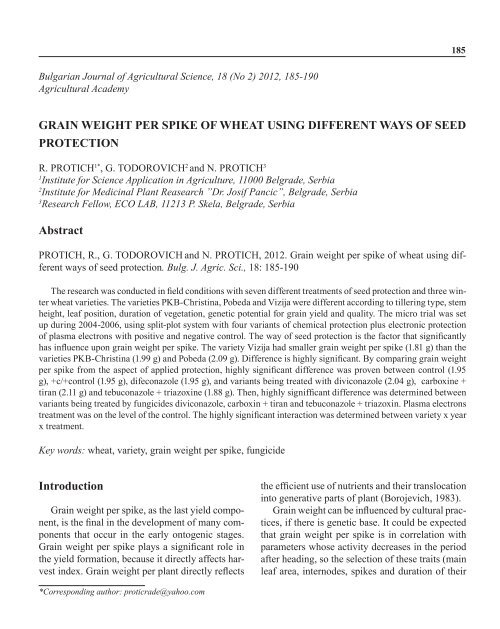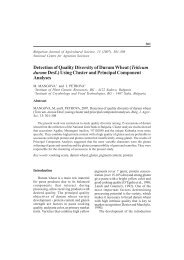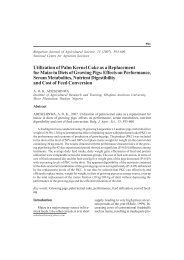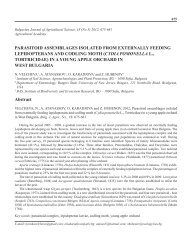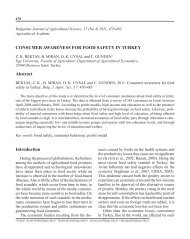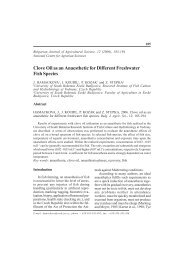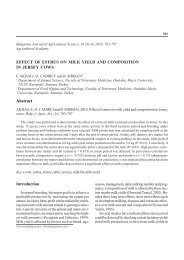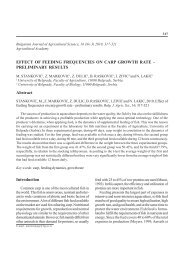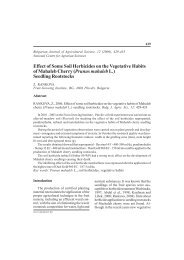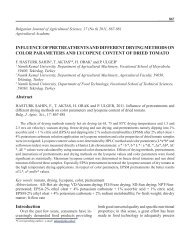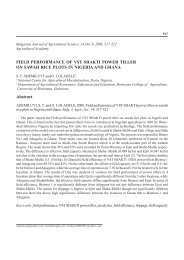See the article as a PDF - Bulgarian Journal of Agricultural Science
See the article as a PDF - Bulgarian Journal of Agricultural Science
See the article as a PDF - Bulgarian Journal of Agricultural Science
You also want an ePaper? Increase the reach of your titles
YUMPU automatically turns print PDFs into web optimized ePapers that Google loves.
185<strong>Bulgarian</strong> <strong>Journal</strong> <strong>of</strong> <strong>Agricultural</strong> <strong>Science</strong>, 18 (No 2) 2012, 185-190<strong>Agricultural</strong> AcademyGRAIN WEIGHT PER SPIKE OF WHEAT USING DIFFERENT WAYS OF SEEDPROTECTIONR. PROTICH 1* , G. TODOROVICH 2 and N. PROTICH 31Institute for <strong>Science</strong> Application in Agriculture, 11000 Belgrade, Serbia2Institute for Medicinal Plant Re<strong>as</strong>earch ”Dr. Josif Pancic”, Belgrade, Serbia3Research Fellow, ECO LAB, 11213 P. Skela, Belgrade, SerbiaAbstractPROTICH, R., G. TODOROVICH and N. PROTICH, 2012. Grain weight per spike <strong>of</strong> wheat using differentways <strong>of</strong> seed protection. Bulg. J. Agric. Sci., 18: 185-190The research w<strong>as</strong> conducted in field conditions with seven different treatments <strong>of</strong> seed protection and three winterwheat varieties. The varieties PKB-Christina, Pobeda and Vizija were different according to tillering type, stemheight, leaf position, duration <strong>of</strong> vegetation, genetic potential for grain yield and quality. The micro trial w<strong>as</strong> setup during 2004-2006, using split-plot system with four variants <strong>of</strong> chemical protection plus electronic protection<strong>of</strong> pl<strong>as</strong>ma electrons with positive and negative control. The way <strong>of</strong> seed protection is <strong>the</strong> factor that significantlyh<strong>as</strong> influence upon grain weight per spike. The variety Vizija had smaller grain weight per spike (1.81 g) than <strong>the</strong>varieties PKB-Christina (1.99 g) and Pobeda (2.09 g). Difference is highly significant. By comparing grain weightper spike from <strong>the</strong> <strong>as</strong>pect <strong>of</strong> applied protection, highly significant difference w<strong>as</strong> proven between control (1.95g), +c/+control (1.95 g), difeconazole (1.95 g), and variants being treated with diviconazole (2.04 g), carboxine +tiran (2.11 g) and tebuconazole + triazoxine (1.88 g). Then, highly signifficant difference w<strong>as</strong> determined betweenvariants being treated by fungicides diviconazole, carboxin + tiran and tebuconazole + triazoxin. Pl<strong>as</strong>ma electronstreatment w<strong>as</strong> on <strong>the</strong> level <strong>of</strong> <strong>the</strong> control. The highly significant interaction w<strong>as</strong> determined between variety x yearx treatment.Key words: wheat, variety, grain weight per spike, fungicideIntroductionGrain weight per spike, <strong>as</strong> <strong>the</strong> l<strong>as</strong>t yield component,is <strong>the</strong> final in <strong>the</strong> development <strong>of</strong> many componentsthat occur in <strong>the</strong> early ontogenic stages.Grain weight per spike plays a significant role in<strong>the</strong> yield formation, because it directly affects harvestindex. Grain weight per plant directly reflects<strong>the</strong> efficient use <strong>of</strong> nutrients and <strong>the</strong>ir translocationinto generative parts <strong>of</strong> plant (Borojevich, 1983).Grain weight can be influenced by cultural practices,if <strong>the</strong>re is genetic b<strong>as</strong>e. It could be expectedthat grain weight per spike is in correlation withparameters whose activity decre<strong>as</strong>es in <strong>the</strong> periodafter heading, so <strong>the</strong> selection <strong>of</strong> <strong>the</strong>se traits (mainleaf area, internodes, spikes and duration <strong>of</strong> <strong>the</strong>ir*Corresponding author: proticrade@yahoo.com
186 R. Protich, G. Todorovich and N. Protichphotosyn<strong>the</strong>tic rates) (Protich, 1980, 1982, 1983),at <strong>the</strong> same time, from leaves and stem to grain is<strong>of</strong> special importance for <strong>the</strong> producing <strong>of</strong> grainweight, because <strong>the</strong>re are genetic differences betweenvarieties, so it is necessary to find genotypesin which that translocation is efficient and to incorporate<strong>the</strong>ir genes into a new variety model.Many varieties are developed and <strong>the</strong>y differaccording to many traits <strong>as</strong> well <strong>as</strong> according tograin weight per spike. For <strong>the</strong>se re<strong>as</strong>ons, <strong>the</strong> aim<strong>of</strong> this study is to determine <strong>the</strong> inheritance mode<strong>of</strong> grain weight per spike in five winter wheat varieties,inheritance in hybrids <strong>of</strong> F 1, F 2generationand backcross generations. This research shouldhelp us in breeding programme aiming to incre<strong>as</strong>egrain weight i.e. to achieve even higher yields thanprevious ones.Material and MethodsThree winter wheat varieties (PKB-Christina,Pobeda and Vizija), which are different accordingto tillering type, stem height, leaf position, duration<strong>of</strong> vegetation, genetic potential for grain yieldand quality, were used in this trial. The experimentw<strong>as</strong> set up in trial field <strong>of</strong> “Tamis” Institutein Panchevo (2003/04 - 2005/06) using split-plotsystem, four replications, including five variants <strong>of</strong>chemical protection plus pl<strong>as</strong>ma electron protection,with positive and negative control. The size<strong>of</strong> elementary plot w<strong>as</strong> 5 m 2 (1 x 5 m). Mechanicalsowing w<strong>as</strong> done in mid-October. Sowing densityw<strong>as</strong> 600 germinating kernels/m 2 and row spacingw<strong>as</strong> 10 cm. <strong>See</strong>d w<strong>as</strong> previously artificially inoculatedwith teleutospores Tilletia tritici (1g/kgseeds). After that, seed w<strong>as</strong> treated with <strong>the</strong> followingactive substances: difeconazole (30 g/l), diviconazole(20g/l), combination <strong>of</strong> carboxin (200g/l)and tiran (200g/l), combination <strong>of</strong> tebuconazole(20g/l) and triazoxin (20g/l). The fifth variant w<strong>as</strong>pl<strong>as</strong>ma electrons seed protection which w<strong>as</strong> doneat Schmidt <strong>See</strong>ger AG, Beilngries, Germany.The sample size for counting number grainweight per spike is 30 spikes in <strong>the</strong> stage <strong>of</strong> fullmaturity.Data were processed statistically using analysis<strong>of</strong> variance by MSTAT - C program, MichiganState University, Version 1. Year, variety and ways<strong>of</strong> seed protection were taken <strong>as</strong> factors in <strong>the</strong> analysis.The results were shown <strong>as</strong> triennial average.Results and DiscussionGrain weight per spike is ano<strong>the</strong>r importantcomponent <strong>of</strong> yield. Change in grain weight perspike dr<strong>as</strong>tically influences <strong>the</strong> final yield. In thisresearch, <strong>the</strong> biggest grain weight per spike had<strong>the</strong> variety Pobeda (2.09 g), <strong>the</strong>n PKB-Christina(1.99 g) and Vizija, which had <strong>the</strong> smallest grainweight per spike (1.81 g). Differences are statisticallyhighly significant (Tables 1 and 2).The variance analysis determined highly significantdifference between years when <strong>the</strong> researchw<strong>as</strong> performed, which is <strong>of</strong>ten seen in this region(Table 1).By comparing grain weight per spike from <strong>the</strong><strong>as</strong>pect <strong>of</strong> applied protection, highly significantdifference w<strong>as</strong> proven between control (1.95 g),+c/+control (1.95 g), difeconazole (1.95 g), andvariants being treated with diviconazole (2.04 g),carboxine + tiran (2.11 g) and tebuconazole + triazoxine(1.88 g). Then, highly signifficant differencew<strong>as</strong> determined between variants being treatedby fungicides diviconazole, carboxin + tiran andtebuconazole + triazoxin. Pl<strong>as</strong>ma electrons treatmentw<strong>as</strong> on <strong>the</strong> level <strong>of</strong> <strong>the</strong> control (Table 2).During <strong>the</strong> years <strong>of</strong> research, <strong>the</strong> variety Pobedahad <strong>the</strong> biggest grain weight per spike (from 1.43to 2.60 g), while <strong>the</strong> variety Vizija had <strong>the</strong> smallestone (from 0.87 to 2.52 g). This interaction ishighly significant (Tables 1 and 2).Grain weight per spike <strong>of</strong> <strong>the</strong> variety Pobedaranged from 1.88 g (in <strong>the</strong> variant being treatedwith fungicide diviconazole) to 2.35 g (<strong>the</strong> variant
188 R. Protich, G. Todorovich and N. ProtichТаble 2Grain weight per spike in gr winter wheat varieties and different way <strong>of</strong> protection <strong>of</strong> artificially inoculatedseed with Tilletia tritici (2003/04 – 2005/06)Year(Y)Way <strong>of</strong> protection(T)Variety (V)PKB-Christina Pobeda VizijaDifeconazole 1.63 1.78 1.53 1.65Diviconazole 1.82 1.42 1.06 1.43Carboxine + Tiran 1.81 1.70 1.12 1.542004 Tebuconazole + Triazoxine 2.13 0.27 0.71 1.04 1.27+C/+ Control 1.17 1.43 0.31 0.97Control 1.30 1.81 0.85 1.32Pl<strong>as</strong>ma electrons 0.82 1.56 0.52 0.97YV x1.53 1.43 0.87Difeconazole 1.95 2.16 2.05 2.05Diviconazole 2.23 1.97 2.38 2.20Carboxine + Tiran 2.27 2.48 1.97 2.242005 Tebuconazole + Triazoxine 2.26 2.47 2.10 2.28 2.14+C/+ Control 2.32 2.14 2.10 2.19Control 2.00 2.05 1.87 1.97Pl<strong>as</strong>ma electrons 2.04 2.31 1.77 2.04YV x 2.15 2.30 2.03Difeconazole 1.60 2.23 2.58 2.14Diviconazole 2.61 2.26 2.63 2.50Carboxine + Tiran 2.42 2.88 2.30 2.532006 Tebuconazole + Triazoxine 1.91 2.36 2.67 2.31 2.48+C/+ Control 2.74 2.76 2.57 2.69Control 2.43 2.86 2.39 2.56Pl<strong>as</strong>ma electrons 2.38 2.87 2.52 2.59YT xYV x2.30 2.60 2.52 T xDifeconazole 1.73 2.06 2.05 1.95Diviconazole 2.22 1.88 2.02 2.04Carboxine + Tiran 2.17 2.35 1.80 2.11(TV x) Tebuconazole + Triazoxine 2.10 1.70 1.83 1.88 1.96+C/+ Control 2.07 2.11 1.66 1.95Control 1.91 2.24 1.70 1.95Pl<strong>as</strong>ma electrons 1.76 2.25 1.60 1.87V x 1.99 2.09 1.81Y xLevel <strong>of</strong> significanceV Y Т VY VТ YТ VYТLSD 5% 0.10 0.06 0.09 0.10 0.15 0.15 0.261% 0.15 0.08 0.12 0.13 0.20 0.20 0.35
Grain Weight per Spike <strong>of</strong> Wheat Using Different Ways <strong>of</strong> <strong>See</strong>d Protection 189between <strong>the</strong>m. Treatment with electronic way <strong>of</strong>protection, pl<strong>as</strong>ma electrons showed significantlylower grain yield than protection with fungicidesand it is controlled. In <strong>the</strong> c<strong>as</strong>e <strong>of</strong> all examinedvariants where seed protection w<strong>as</strong> done, significantdifference concerning grain yield in comparisonto control, w<strong>as</strong> established. Highly significantdifference w<strong>as</strong> established between <strong>the</strong> years whenresearch w<strong>as</strong> carried out <strong>as</strong> well <strong>as</strong> variety x yearinteraction (Protich et al., 2011).The efficacy <strong>of</strong> seed treatment and foliar spraywith fungicides in controlling black point incidence<strong>of</strong> wheat seeds w<strong>as</strong> evaluated in <strong>the</strong> field.Untreated and unsprayed controls were also maintained.<strong>See</strong>d treatment with ei<strong>the</strong>r Vitavax-200 orHomai-80WP significantly incre<strong>as</strong>ed plant populationand grain yield, but none <strong>of</strong> <strong>the</strong>m w<strong>as</strong> foundeffective in reducing black point incidence. However,no significant incre<strong>as</strong>e in spike length, spikeweight or 1000-grain weight w<strong>as</strong> observed when<strong>the</strong> seeds were treated with any <strong>of</strong> <strong>the</strong> two fungicides.The incre<strong>as</strong>e in grain yield due to seed treatmentw<strong>as</strong> attributed to incre<strong>as</strong>e in number <strong>of</strong> spikesper square meter and grains per spike (Malaker andMian, 2009).The chemical plant protection methods applied,<strong>as</strong> compared with <strong>the</strong> control incre<strong>as</strong>ed <strong>the</strong> number<strong>of</strong> spikes per area unit, number <strong>of</strong> grains per spikeand 1000 grain weight, which enhanced <strong>the</strong> productivityper spike. Wheat grain yield for <strong>the</strong> seeddressing treatments w<strong>as</strong> significantly higher than<strong>the</strong> no-protection yields. The plant protectionmethod which involved dressed sowing seed and2-time fungicide treatment (2x) w<strong>as</strong> more favourableto <strong>the</strong> grain yield than seed dressing and a singlefungicide treatment (Barbara et al., 2009).ConclusionsThe way <strong>of</strong> seed protection is <strong>the</strong> factor thatsignificantly h<strong>as</strong> influence upon grain weight perspike. The variety Vizija had smaller grain weightper spike (1.81 g) than <strong>the</strong> varieties PKB-Christina(1.99 g) and Pobeda (2.09 g). Difference is highlysignificant. By comparing grain weight per spikefrom <strong>the</strong> <strong>as</strong>pect <strong>of</strong> applied protection, highly significantdifference w<strong>as</strong> proven between control(1.95 g), +c/+control (1.95 g), difeconazole (1.95g), and variants being treated with diviconazole(2.04 g), carboxine + tiran (2.11 g) and tebuconazole+ triazoxine (1.88 g). Then, highly signifficantdifference w<strong>as</strong> determined between variantsbeing treated by fungicides diviconazole, carboxin+ tiran and tebuconazole + triazoxin. Pl<strong>as</strong>ma electronstreatment w<strong>as</strong> on <strong>the</strong> level <strong>of</strong> <strong>the</strong> control. Thehighly significant interaction w<strong>as</strong> determined betweenvariety x year x treatmentAcknowledgementsThis paper presents results <strong>of</strong> <strong>the</strong> project TR31066 “Modern breeding <strong>of</strong> cereals for currentand future needs”, supported by Ministry <strong>of</strong> <strong>Science</strong>and Technological Development <strong>of</strong> RepublicSerbia.ReferencesBarbara, C. D., K. Andrzej and B. Jarosław, 2009.Effect <strong>of</strong> selected agrotechnical factors on winterdurum wheat yielding. Electronic <strong>Journal</strong> <strong>of</strong> Polish<strong>Agricultural</strong>, 12: 3: 02.Borojevich, S., 1983. Genetic and technologicalchanges which caused a change in plant breeding.BANU, Novi Sad, Akademska beseda, 100 pp. (Sr).Kobiljski, B., S. Dencich and S. Khairallah, 1996.Efekti veličine kl<strong>as</strong>a na komponente prinosa i prinospšenice. Selekcija i semenarstvo, 3: 27-31 (Sr).Kraljevich-Balalich, M., 1978. The inheritance <strong>of</strong>plant height and some o<strong>the</strong>r yield components invulgare wheat. Genetika, 10 (1): 31-42.Protich, R., 1980. Research <strong>of</strong> optimal index and leafarea duration in different wheat genotypes. Doctoraldissertation, Faculty <strong>of</strong> Agriculture, Novi Sad, pp.1-145 (Sr).Protich, R., 1982. Dependence <strong>of</strong> grain yields <strong>of</strong> index
190 R. Protich, G. Todorovich and N. Protichand leaf area duration in different wheat varieties.Nauka u praksi, 12 (2): 171-186 (Sr).Protich, R., 1983. The influence <strong>of</strong> planting densityand plant space arrangement on <strong>the</strong> leaf area andgrain yield <strong>of</strong> different wheat genotypes. Nauka upraksi, 13 (4): 451-465 (Sr).Protich, R., M. Markovich and N. Protich, 2007. Effects<strong>of</strong> different ways <strong>of</strong> seed protection on some yieldcomponents grain yield winter wheat. RoumanianBiotechnological Letters, 12 (5): 3435-3440.Protich, R., G. Todorovich, N. Protich and D.Vichentijevich, 2011.Test weight <strong>of</strong> differentwinter wheat genotypes using different ways <strong>of</strong>seed protection. Romanian <strong>Agricultural</strong> Research,28 (in press).Protich, R., G. Todorovich and N. Protich, 2011.Еffects <strong>of</strong> Winter Wheat <strong>See</strong>d Protection againstTilletia tritici on Grain Yield. <strong>Bulgarian</strong> <strong>Journal</strong> <strong>of</strong><strong>Agricultural</strong> <strong>Science</strong>, 17 (5): (in press).Protich , R., G. Todorovich and N. Protich, 2011.M<strong>as</strong>s <strong>of</strong> 1000 grains in <strong>the</strong> c<strong>as</strong>e <strong>of</strong> several winterwheat genotypes using different ways <strong>of</strong> seedprotection. Romanian <strong>Agricultural</strong> Research, 28:(in press).Malaker, P. K. and I. H. Mian, 2009. Effect <strong>of</strong>seed treatment and foliar spray with fungicides incontrolling black point dise<strong>as</strong>e <strong>of</strong> wheat. BangladeshJ. Agril. Res., 34 (3): 425-434.Received July, 9, 2011; accepted for printing February, 2, 2012.


